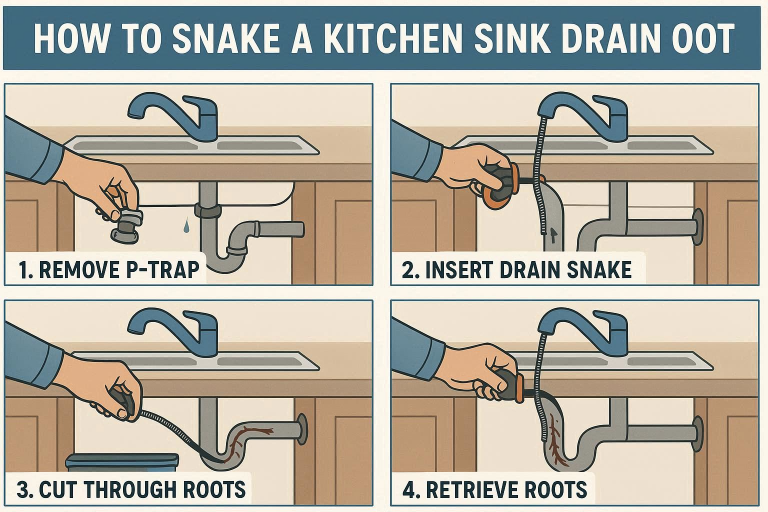A clogged kitchen sink can quickly turn from a small inconvenience to a major plumbing headache, especially if the issue is tree roots infiltrating your pipes. If you’re dealing with a kitchen sink drain clogged by roots, you’re not alone. This is a common problem, particularly in homes with older plumbing systems or large trees nearby. Luckily, there’s a simple and effective tool to fix it—drain snakes.
In this guide, we’ll walk you through how to snake a kitchen sink drain for roots, the best tools to use, how to deal with a garbage disposal, and everything in between. By the end, you’ll be equipped with the knowledge you need to clear that kitchen sink clog and keep your plumbing running smoothly.
What Causes Roots in Kitchen Sink Drains?
Root Infiltration in Pipes
Tree roots are naturally drawn to the moisture in your pipes, which makes your plumbing system an inviting target. When roots seek out these water sources, they slowly infiltrate underground pipes, causing cracks, leaks, and eventually blockages. This is especially common in older plumbing systems with clay pipes, which are more susceptible to root infiltration.
Signs of Root Blockage
It can be tricky to diagnose root blockages because the symptoms are often subtle at first. Here’s what to watch for:
- Slow Draining: Water doesn’t drain as quickly as it should.
- Gurgling Sounds: Air is trapped in the pipes due to a partial blockage.
- Frequent Clogs: You might clear the clog temporarily, but it comes back often, indicating a deeper, more persistent issue.
Impact on Kitchen Sink Drains
Roots typically enter the pipes through small cracks or joints, and as they grow, they can block or even collapse the pipe. This can lead to multiple clogs, slow drainage, and unpleasant odors in the kitchen sink. In extreme cases, the roots may even damage the pipe permanently, requiring expensive repairs.
Best Drain Snake for Kitchen Sink
When dealing with a root clog, the right drain snake can make all the difference. Let’s go over the types of drain snakes, key features to look for, and some recommendations.
Types of Drain Snakes
- Manual Drain Snakes: These are the traditional, handheld versions that you manually rotate and feed into the drain. They’re effective for most small to medium blockages.
- Powered Drain Snakes: These are electric or battery-powered, which makes them easier to use and more powerful for stubborn clogs, like roots.
- Auger vs. Flexible Snakes: An auger has a rigid, spiral coil, while flexible snakes are more bendable and can reach around corners. For roots, a rigid auger is often a better choice, as it can cut through tougher obstructions.
Key Features to Look For
- Length: For kitchen sink drains, a snake should typically be between 15 to 25 feet long to reach clogs that are further down the line.
- Flexibility: A snake with a flexible cable is ideal for getting around bends, but too much flexibility may reduce its power to cut through roots.
- Durability: Look for a snake with durable construction, especially if you’ll be using it for tough blockages like tree roots.
Recommended Models
- RIDGID K-3: A popular manual drain snake that’s perfect for small to medium kitchen sink clogs.
- Greenlee 7000: A more powerful powered auger ideal for clearing tree roots.
- Drain King Drain Bladder: A great option if you’re dealing with a non-invasive clog (not roots) and need an easier solution.
Can You Use a Snake to Unclog a Kitchen Sink?
Yes, a drain snake is one of the most effective ways to clear a clogged kitchen sink drain, especially if the clog is caused by tree roots. Here’s how a drain snake works:
How Snakes Work
Drain snakes, also known as augers, are designed to break through or grab onto clogs and roots. As you rotate the snake, it either pushes through the blockage or pulls it out, restoring the flow of water.
When to Use a Snake
Snaking is typically recommended when:
- Plungers or chemical drain cleaners don’t work.
- The clog is deeper in the drain line or caused by roots.
- You’ve experienced recurring clogs despite basic cleaning methods.
Limitations of Snaking
While snaking is effective for many clogs, it isn’t always a permanent solution:
- Severe blockages: If the pipe is completely blocked, snaking alone might not suffice.
- Damaged pipes: If roots have severely cracked the pipe, snaking may only be a temporary fix, and pipe repair might be necessary.
How to Use a Snake to Unclog a Kitchen Sink
Follow these steps to snake your kitchen sink drain effectively.
Step 1: Prepare for the Job
- Turn off the water supply: Shut off the water supply to your sink to prevent spills.
- Place a bucket under the sink: This will catch any debris or water that may spill out while you work.
- Wear gloves and eye protection: Protect yourself from any debris or chemicals.
Step 2: Choose the Right Snake
- Manual or Electric: If you’re dealing with roots, a powered snake might be more effective, but a manual one can work for less severe clogs.
- Size and Flexibility: Make sure the snake is long enough (15-25 feet) and flexible enough to navigate your drain.
Step 3: Insert the Snake
- Slowly feed the snake into the drain, keeping the cable straight. As you push the snake forward, rotate the handle to help it maneuver through the pipes.
Step 4: Rotate and Push the Snake
- Rotate the snake while gently applying pressure to push it through the blockage. If roots are involved, you may need to apply more force and patience as you work through the obstruction.
Step 5: Pull Out the Snake and Clear the Debris
- Once the snake has broken through the clog or roots, slowly pull it out while continuing to rotate it. Be prepared to remove root fragments and gunk stuck to the snake.
Step 6: Test the Drain
- After clearing the blockage, run water through the sink to ensure the drainage has improved and there are no more issues.
How to Snake a Kitchen Sink with Garbage Disposal
Preparation for Snaking with a Garbage Disposal
If your kitchen sink has a garbage disposal, extra precautions are needed. Always turn off the power to the disposal before beginning to snake the drain.
Accessing the Drain
- Insert the snake below the disposal: Reach under the sink, insert the snake into the drainpipe, and work it through as you would with a standard drain. The snake should be able to reach the problem area, bypassing the disposal itself.
Safety Measures
- Ensure the garbage disposal is completely powered off to avoid injury or damage while snaking.
- Don’t force the snake too hard to avoid damaging the disposal.
What Size Snake for Kitchen Drain?
Choosing the Right Size Snake
For most kitchen sinks, a 1/4-inch to 1/2-inch diameter snake is ideal. These sizes are versatile enough to handle most blockages, including roots and debris.
Length Considerations
- 15 to 25 feet is typically the ideal length for snaking a kitchen sink drain. If the roots are deeper, you might need a longer snake.
Types of Snakes for Different Clogs
- Smaller snakes are better for regular blockages, while larger, more rigid snakes are ideal for tackling tree roots.
What Kills Roots in Drain Pipes?
In addition to snaking, there are a few methods for dealing with tree roots in your pipes:
Chemical Root Killers
Chemical products like Copper Sulfate and Foaming Root Killers are commonly used to kill roots in pipes. These products work by breaking down the roots, clearing the blockage, and preventing further growth.
Natural Methods
If you prefer non-toxic methods, you can try products like enzyme-based cleaners that slowly break down roots over time. However, they are often less effective for large, established root blockages.
Prevention
Installing root barriers and performing regular maintenance are excellent ways to prevent roots from entering your pipes in the first place.
Kitchen Sink Clogged on Both Sides?
Common Causes of Dual Clogs
Dual clogs occur when both sides of a double sink drain back up at the same time. This can be caused by a shared trap or a blockage in the main drain line.
How to Resolve Double Sink Clogs
To clear a dual sink clog, start by snaking both drain lines and the P-trap area. You may need to snake both sides of the sink to ensure complete blockage removal.
Common Challenges When Snaking a Kitchen Sink Drain
Dealing with Hard-to-Reach Roots
Roots often grow deep into pipes, making them difficult to remove. You may need a more powerful powered snake or professional help in severe cases.
Limited Access Under the Sink
Tight spaces can make it difficult to maneuver a drain snake. Use a flexible snake to navigate these areas more effectively.
Stubborn Clogs
If the clog remains after multiple attempts with the snake, it’s time to consider calling a plumber.
FAQ: Frequently Asked Questions About Snaking Kitchen Sink Drains
How Do I Know If Roots Are Clogging My Kitchen Sink Drain?
Look for slow drainage, gurgling sounds, or frequent clogs that keep coming back.
Can I Use a Snake to Unclog a Kitchen Sink with a Garbage Disposal?
Yes, but always make sure the disposal is turned off before snaking.
What Is the Best Snake for Kitchen Sink Drains?
The best snakes for kitchen sink drains are typically manual or powered augers, depending on the severity of the clog.
What Should I Do if a Snake Doesn’t Work for My Kitchen Drain?
If snaking doesn’t clear the clog, try using a root killer, or consult a plumber for more advanced solutions.
Conclusion
Knowing how to snake a kitchen sink drain for roots is an invaluable skill that can save you time, money, and frustration. By following the right steps, using the best tools, and knowing when to seek professional help, you can keep your kitchen drains flowing smoothly.
Additional Resources
- Choosing the Right Drain Snake
- How to Prevent Future Clogs in Kitchen Sinks
- Best Drain Cleaning Products for Homeowners

